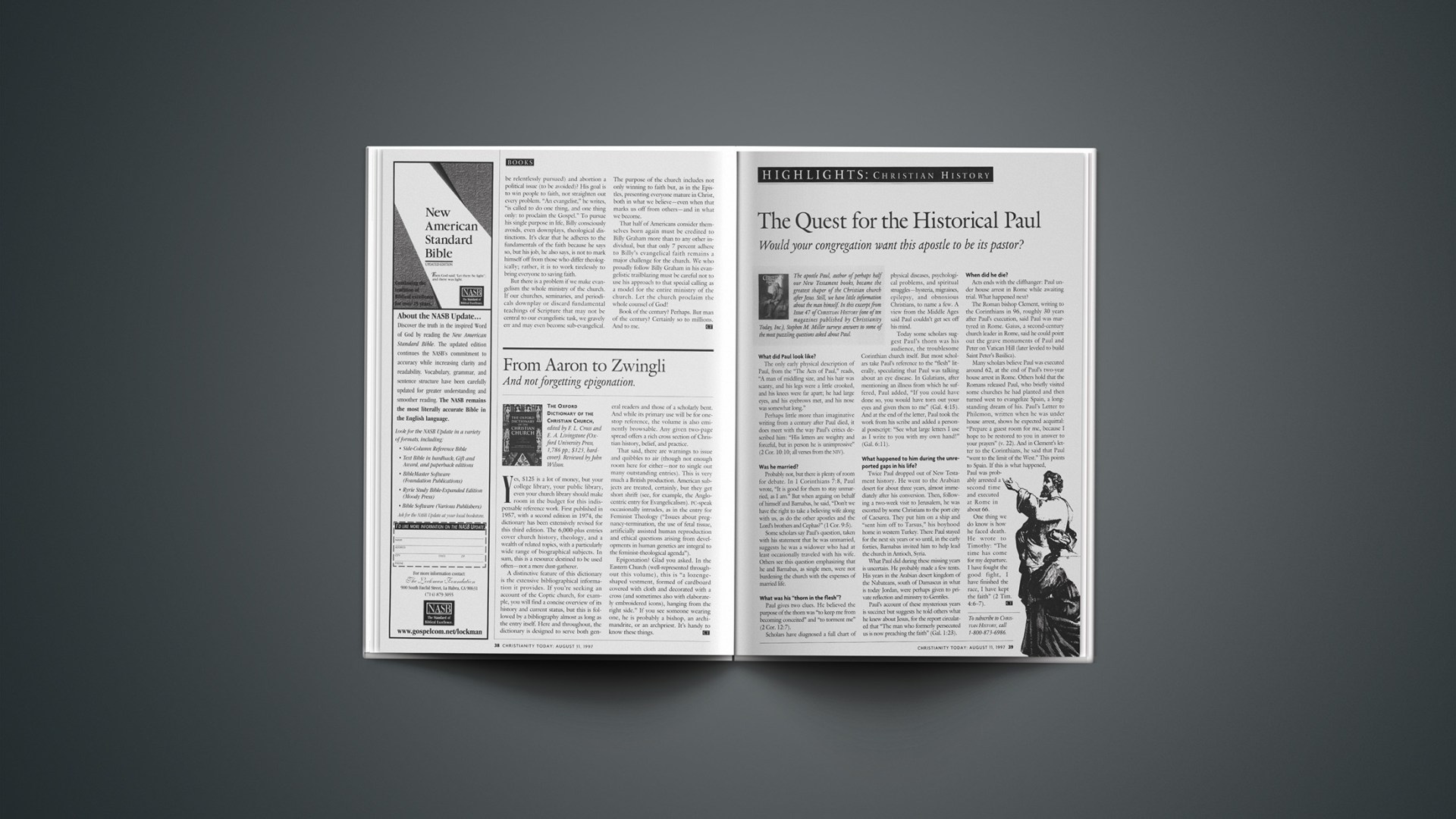The apostle Paul, author of perhaps half our New Testament books, became the greatest shaper of the Christian church after Jesus. Still, we have little information about the man himself. In this excerpt from Issue 47 of Christian History (one of ten magazines published by Christianity Today), Stephen M. Miller surveys answers to some of the most puzzling questions asked about Paul.
What did Paul look like? The only early physical description of Paul, from the “The Acts of Paul,” reads, “A man of middling size, and his hair was scanty, and his legs were a little crooked, and his knees were far apart; he had large eyes, and his eyebrows met, and his nose was somewhat long.”
Perhaps little more than imaginative writing from a century after Paul died, it does meet with the way Paul’s critics described him: “His letters are weighty and forceful, but in person he is unimpressive” (2 Cor. 10:10; all verses from the NIV).
Was he married? Probably not, but there is plenty of room for debate. In 1 Corinthians 7:8, Paul wrote, “It is good for them to stay unmarried, as I am.” But when arguing on behalf of himself and Barnabas, he said, “Don’t we have the right to take a believing wife along with us, as do the other apostles and the Lord’s brothers and Cephas?” (1 Cor. 9:5).
Some scholars say Paul’s question, taken with his statement that he was unmarried, suggests he was a widower who had at least occasionally traveled with his wife. Others see this question emphasizing that he and Barnabas, as single men, were not burdening the church with the expenses of married life.
What was his “thorn in the flesh”? Paul gives two clues. He believed the purpose of the thorn was “to keep me from becoming conceited” and “to torment me” (2 Cor. 12:7).
Scholars have diagnosed a full chart of physical diseases, psychological problems, and spiritual struggles—hysteria, migraines, epilepsy, and obnoxious Christians, to name a few. A view from the Middle Ages said Paul couldn’t get sex off his mind.
Today some scholars suggest Paul’s thorn was his audience, the troublesome Corinthian church itself. But most scholars take Paul’s reference to the “flesh” literally, speculating that Paul was talking about an eye disease. In Galatians, after mentioning an illness from which he suffered, Paul added, “If you could have done so, you would have torn out your eyes and given them to me” (Gal. 4:15). And at the end of the letter, Paul took the work from his scribe and added a personal postscript: “See what large letters I use as I write to you with my own hand!” (Gal. 6:11).
What happened to him during the unreported gaps in his life? Twice Paul dropped out of New Testament history. He went to the Arabian desert for about three years, almost immediately after his conversion. Then, following a two-week visit to Jerusalem, he was escorted by some Christians to the port city of Caesarea. They put him on a ship and “sent him off to Tarsus,” his boyhood home in western Turkey. There Paul stayed for the next six years or so until, in the early forties, Barnabas invited him to help lead the church in Antioch, Syria.
What Paul did during these missing years is uncertain. He probably made a few tents. His years in the Arabian desert kingdom of the Nabateans, south of Damascus in what is today Jordan, were perhaps given to private reflection and ministry to Gentiles.
Paul’s account of these mysterious years is succinct but suggests he told others what he knew about Jesus, for the report circulated that “The man who formerly persecuted us is now preaching the faith” (Gal. 1:23).
When did he die? Acts ends with the cliffhanger: Paul under house arrest in Rome while awaiting trial. What happened next?
The Roman bishop Clement, writing to the Corinthians in 96, roughly 30 years after Paul’s execution, said Paul was martyred in Rome. Gaius, a second-century church leader in Rome, said he could point out the grave monuments of Paul and Peter on Vatican Hill (later leveled to build Saint Peter’s Basilica).
Many scholars believe Paul was executed around 62, at the end of Paul’s two-year house arrest in Rome. Others hold that the Romans released Paul, who briefly visited some churches he had planted and then turned west to evangelize Spain, a long-standing dream of his. Paul’s Letter to Philemon, written when he was under house arrest, shows he expected acquittal: “Prepare a guest room for me, because I hope to be restored to you in answer to your prayers” (v. 22). And in Clement’s letter to the Corinthians, he said that Paul “went to the limit of the West.” This points to Spain. If this is what happened, Paul was probably arrested a second time and executed at Rome in about 66.
One thing we do know is how he faced death. He wrote to Timothy: “The time has come for my departure. I have fought the good fight, I have finished the race, I have kept the faith” (2 Tim. 4:6-7).
To subscribe to Christian History, call 1-800-873-6986.
Copyright © 1997 Christianity Today. Click for reprint information.










